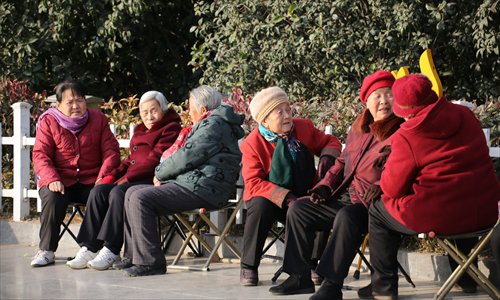Reform of pension system worries public sector workers
Following new reforms, from October 2015, China's 40 million public sector employees will have to pay into the State pension system, as the government seeks to create a more equal and solvent system. Pension reform is one of the most challenging reforms that China has undertaken. The reform means that the national pension scheme will become a system in which employers, individuals and the government take joint responsibility for pensions. But many are worried about having their pensions and salaries cut and about the overall cost of these reforms.

Elderly people sit in a park in Xuchang, Central China's Henan Province, on January 1. Photo: CFP

Photo: CFP
Doctors, teachers and other public sector workers in China are worried. Some have even gone on strike. But they aren't worried about their working conditions. They are worried about what will happen to them when they retire.
In some central and western Chinese regions, it has been reported that many civil servants have been applying for early retirement.
These people are seeking to leave the world of work early due to last week's State Council announcement of pension reform. This has led to many civil servants worrying that they might not receive the pension they have expected.
Zhang Chewei, vice dean of the Institute of Population and Labor Economics, Chinese Academy of Social Sciences (CASS), told the China National Radio that these worries about reduced pension payments are understandable, but that it is not easy to be granted early retirement.
The State Council announced its plans for a new pension scheme for civil servants and those employed by public institutions on January 14. The new system is to come into force from October 2015.
Under the old system, public sector workers did not have to pay into a pension fund and their pension was paid for by the State. Their pension payments were nearly 90 percent of their pre-retirement monthly salary.
But under the new system, the size of pension payments will mainly be decided by how much retirees have paid into their pension fund, and for how long. This would bring public sector workers more in line with their private sector counterparts who must pay 8 percent of their monthly salary into a pension fund.
Private employers must also pay 20 percent of their workers' salaries into a pension fund. Usually, the pensions of private sector employees are equal to 40 to 60 percent of their final salary.
This gap has led to discontent among private sector workers, who have called for the government to create a fairer system.
These reforms will aim to create a more equal and solvent system, as pensions in China are under increasing pressure from an aging society.
Deficit reduction
In making this announcement, China is taking on one of the most challenging areas of reform - the long-running dual pension system.
China had nearly 7.2 million civil servants and more than 31.5 million public sector workers employed by institutions such as schools and hospitals at the end of 2013, according to official figures.
Of these workers, China's 2 million medical doctors and 17 million teachers are the people who will mostly be affected by this reform as they make up the majority of public sector workers.
Zhu Lijia, professor at the Chinese Academy of Governance, told the Global Times that the new scheme will likely "start with setting a direction and moving things along gradually to weed out discrepancies in the pension system."
The goal is to develop a unified pension scheme that covers both public sector and private sector employees. Scholars have said that the plan represents "a major step" toward a more equitable and balanced system.
According to a report on China's pension fund development released by the CASS in late December, a total of 19 provincial-level regions had pension deficits in 2013, with a total shortfall of 170.2 billion yuan ($27.4 billion).
China's rapidly aging population has led to a decrease in the proportion of the country that is paying into pension funds but an increase in the number of people receiving pensions. It is also considered one of the major reasons to the introduction of the pension reform.
Official figures show that the number of people above 60 years old has exceeded 200 million, accounting for 14.9 percent of the total population.
Fears and protests
Zhu Lijia said that people's worries about their retirement benefits being cut from today's level has sparked the rush for the door by some teachers and doctors.
In some places where these reforms have been experimented, these fears have led to widespread uneasiness.
In November, about 8,000 teachers in the city of Zhaodong, an agricultural hub in Northeast China's Heilongjiang Province, went on strike for three days to protest an experimental pension scheme, caixin.com reported.
They believed that the new scheme would force them to take a pay cut.
The teachers claimed they had been illegally made to participate in the scheme, and demanded the local government refund the money that had been deducted from their salaries to put into the pension fund, according to the report.
The dispute in Zhaodong provides us with a snapshot of the national debate over pension system reform.
Twenty-eight percent of the base salaries of private sector workers must be paid into pension funds. The reason that the pension payments made to them during retirement are relatively small is that they have to share the pension fund with older retirees that made little or no contribution to the fund.
Under the reform plan, public sector workers would have to make the same 28 percent payment into a pension fund.
Hong Kong-based Wen Wei Po newspaper reported on Sunday that the country plans to increase the salaries of civil servants nationwide up by to 60 percent. But it is unclear whether or not other public sector employees will be getting a pay increase to offset the costs of paying into the new pension schemes.
Zheng Bingwen, a social security researcher with the CASS, claims that under the new pension system all workers would be treated equally.
The reform means the national pension system will become a multi-channel financing and funding system, where employers, individuals and the government take joint responsibility, Zheng said.
Tang Jun, a sociology professor at the CASS, told the Global Times that the pension reform process which started in the 1990s - when the government began to pay for the pensions of State-owned enterprise (SOE) employees - generated huge "reform costs," and it has taken a long time to digest these costs.
Tang argued that one way for the "reform costs" to be covered in this case would be for SOE dividends to be used to pay for public pension funds.
The new pension scheme will be implemented by splitting workers into three groups: old, new and middle. "Old people" are those who retired before the reforms come into effect. "New people" are employees who start work after the reforms. "Middle people" are those who began working before the reform and will retire after the reform. The general principle will be "old people, old rule; new people, new rule; middle people gradually transfer into the new system."
The exact details of implementation are yet to be disclosed.
The Chinese government has extensively expanded the number of people covered by public pension schemes. A total of 830 million people are currently covered by a public pension schemes. The average pension of urban workers is 2,070 yuan per month, according to the Xinhua News Agency.
Still, lots of citizens still lack of social security when they retire. It is estimated only 20 to 30 percent of private enterprise employees are covered by a pension sufficient to pay their living costs during retirement. Many migrant workers are not covered by any pension scheme.
In 2009, China started to provide a pension to farmers over 60 years old. The payments, differing due to different local economic situations, range from 50 yuan to 220 yuan per month.
Assessment methods
While scholars have hailed the central government's pension plan as an important step in tacking inequality, at the local level there is concern about the fact that the special details have not been announced.
"It is the salary and welfare we are concerned about," said a civil servant in Huzhou, East China's Zhejiang Province.
"In the old system, the salary level is clear. We just don't know how much money we will really receive in the new plan. Will the new plan create inequality between different levels of civil servants?" he asked.
"The details of this retirement plan still need to be disclosed. How will the retirement program be arranged? Will our retirement payments decrease? That is our real concern," the civil servant said.
Su Hainan, vice director of the China Association for Labor Studies, thinks that the reform of pensions cannot just be regarded as a simple reform of funding methods. It will also push forward the performance of all employees as it will form a parallel system of performance evaluation.
The pensions will be based both on the positions of officials and also on the performance of common employees. It will mean that those who are not officials can also obtain higher pension payments according to the quality of their work, as well as their final salaries, Su explained.
Many people have welcomed these reforms, especially young workers, as the new pension scheme allows pension funds to be mobile and movable. The pension account can follow the holder between different jobs and the balance of pension is transferrable.
"It will provide us more freedom to choose jobs. In the old system, we are stuck with our old work units because our pension is there. The pension can't move with us. The new rules will provide us freedom to change jobs, because our pension under new system will go with us," a human resources manager with a State-owned company in Beijing told the Global Times on condition of anonymity.
"Also, the new system will set up a professional system to evaluate employee's salary levels. So that an employee can be paid in accordance with their professional capability, not just on their position. It is very reasonable," she said.
Newspaper headline: Retirement ruckus